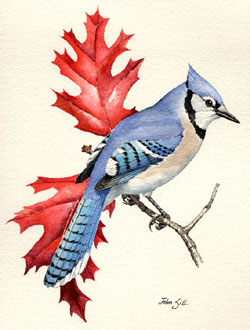Breeding Bird Atlases (BBA)
Find a Bird - BBA1
Breeding Bird Atlas 1 Species Accounts
Blue Jay
Cyanocitta cristata
Egg Dates
April 28 to June 28
Number of Broods
one; may re-lay if first attempt fails.

The Blue Jay is a common and conspicuous bird in Massachusetts. Traditionally a species of the forests, it has adapted well to civilization and is found presently throughout the state from the high mixed forests of the Berkshire Hills to low wooded thickets along the coast, suburban yards, and even densely populated urban areas.
Although Blue Jays can be found throughout the year in Massachusetts, migrations do occur as well as local movements within the population. Some individuals may remain in Massachusetts year-round. Spring migration in eastern sections begins in early March and ends in May. It is delayed a few weeks in the high western elevations and may continue into early June. Peak migration counts may total several hundred jays.
The Blue Jay has an impressive vocabulary. It is an outstanding mimic and ventriloquist as well. One of the commonest calls is described as a loud, harsh jay or jeer. Another familiar call is a creaking wheedle-wheedle or whee-oodle. The jay is also credited with a soft, delicate warble, which it delivers from some secluded spot. Among the calls imitated are those of several hawk species. Jays are normally quite loud and boisterous for most of the year, and they are quick to band together to announce the presence of an avian predator or other source of danger with their piercing cries. During the nesting season and the molt period that follows, they tend to be less conspicuous.
There is no elaborate courtship display. Instead, several males follow a female about, bobbing up and down before her and hopping among the branches of a tree. Little vocalizing is done during these activities. Courtship feeding of the female by the male has been observed. Some banding records indicate that mated pairs will remain together for several years.
Nests are built in a variety of trees and shrubs. Twenty-five Massachusetts nests were situated as follows: White Pine (4 nests), spruce (3 nests), yew (1 nest), unidentified conifers (5 nests), oak (3 nests), American Beech (2 nests), Black Cherry (2 nests), Multiflora Rose (2 nests), magnolia (1 nest), pyracantha (1 nest), and American Holly (1 nest). Heights ranged from 3 to 30 feet and averaged 11.5 feet (CNR). The nest is situated either in a crotch or among the outer branches. It is a bulky structure about 8 inches in diameter and 4 inches in height. The outer framework consists of dead twigs interlaced with bark, string, paper, or forest litter; and the inner cup, approximately 4 inches in diameter, is composed of fine rootlets.
Egg laying generally takes place from April into May, but if the eggs or nestlings are lost the birds will renest into June. Eggs are deposited one per day until a clutch of two to seven (usually four or five) eggs is completed. The clutch sizes in 22 Massachusetts nests were as follows: two eggs (1 nest), three eggs (3 nests), four eggs (12 nests), five eggs (5 nests), and six eggs (1 nest) (CNR). The eggs are variable, with olive or buff ground color and scattered, irregular, brownish spots.
Incubation lasts 16 to 18 days. Upon hatching, the young are blind and naked, but they develop rapidly and leave the nest at 17 to 21 days of age. The female performs most of the incubation and brooding. The male brings food to her initially and later helps feed the young. Jays are devoted parents and will defend their brood fiercely from predators. Hatching in 8 Massachusetts nests occurred between May 24 and June 8 and in 3 nests from June 18 to June 28 (CNR). Brood size ranged from one to six, with two, three, and four young the most common. Of 32 state nests, 10 had an unknown outcome, 9 fledged at least one young, and 13 failed (CNR). The earliest recorded fledge date was June 6 (CNR), and the latest record of a dependent youngster was August 14 (Meservey). Adults undergo a postnuptial molt from late June to September. During this time, the fledglings acquire their first winter plumage. The sexes are identical in color and pattern.
The diet of Blue Jays is approximately 75 percent vegetal and 25 percent animal, but these percentages are subject to seasonal variations. During autumn months, jays gather in loose flocks and feed heavily on mast, especially acorns, caching many more than they eat. This habit of burying acorns greatly enhances the germination and early growth of oak woodlands. Occasionally, jays will prey upon the eggs and young of other bird species.
Starting in mid-September, Blue Jays begin a southward migration through Massachusetts. This move- ment lasts until late October, and daily counts are usually higher than during the spring months and sometimes number in the thousands. Large migrations occur during periods of good weather when there has been a failure of the mast crop. Severe weather or a shortage of food will force jays from higher, exposed locations to lower elevations along the coast and inland valleys. Winter survival of the Blue Jays and other species has increased over the past several decades due to the growing number of bird feeding stations.
Map Legend and Data Summary
Atlas 1 data collected from 1975-1979


Note: common and widespread in a wide variety of habitats
Anthony A. Gola



